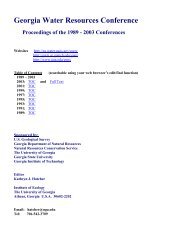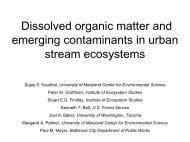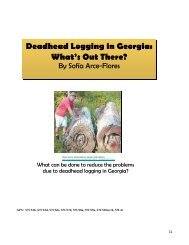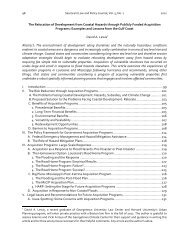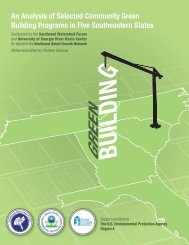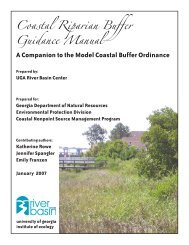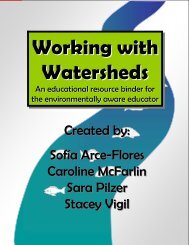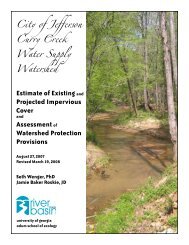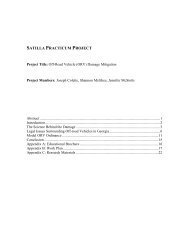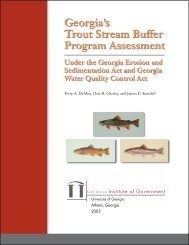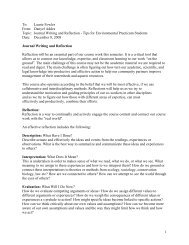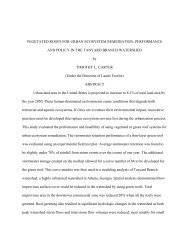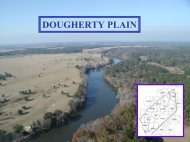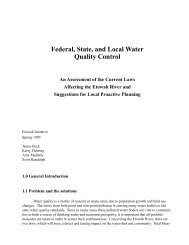1 Bibliographic Review of Sources Relevant to Development of Draft ...
1 Bibliographic Review of Sources Relevant to Development of Draft ...
1 Bibliographic Review of Sources Relevant to Development of Draft ...
You also want an ePaper? Increase the reach of your titles
YUMPU automatically turns print PDFs into web optimized ePapers that Google loves.
Savannah River Annotated Bibliography: January 2003<br />
cross section, and sand substrate. All ages <strong>of</strong> shortnose selected a range <strong>of</strong> habitats.<br />
Showed a preference for curves with sand or cobble substrate and avoided runs,<br />
especially in fall, probably because <strong>of</strong> slow water velocity. Winter habitat selection<br />
patterned the fall, but was less variable.<br />
Kynard, B., and M. Horgan. 2002. On<strong>to</strong>genetic behavior and migration <strong>of</strong> Atlantic<br />
sturgeon Acipenser oxyrinchus oxyrinchus, and shortnose sturgeon, A. brevirostrum,<br />
with notes on social behavior. Environmental Biology <strong>of</strong> Fishes. 63, 137-150.<br />
Labora<strong>to</strong>ry studies <strong>of</strong> embryo and larva temporal and spatial movement patterns <strong>of</strong><br />
Hudson River Atlantic sturgeon and Connecticut River shortnose sturgeon were<br />
examined as well as the foraging relationship <strong>to</strong> body size. Atlantic sturgeon<br />
embryos sought cover in gravel substrate until day eight <strong>of</strong> development and<br />
shortnose sturgeon emerged as larva at 16-17 days old. Atlantic sturgeon spawn at<br />
rkm 136-182 and larva have a long 1-step migration <strong>of</strong> 6-12 days. Shortnose<br />
sturgeon spawn at rkm 192-194 and have a long 2 step migration downstream for 3<br />
days. A good review <strong>of</strong> life his<strong>to</strong>ry and early life movement patterns is given.<br />
Smith, T.I.J. 1985. The fishery, biology, and management <strong>of</strong> Atlantic sturgeon, Acipenser<br />
oxyrhynchus, in North America. Environmental Biology <strong>of</strong> Fishes. 14,61-72.<br />
The decline <strong>of</strong> the Atlantic sturgeon and the shortnose sturgeon is described here and<br />
landings/ year and landings/ year/ state are presented. A good summary <strong>of</strong> the<br />
biology at various life stages is presented here. Timing <strong>of</strong> Atlantic sturgeon<br />
spawning migrations are temperature dependent and adults arrive in inland waters in<br />
February- March. Probable spawning areas for Atlantic sturgeon is in running water<br />
over bot<strong>to</strong>ms containing rocks, rubble, and other hard objects and in pools below<br />
waterfalls. There is evidence that juveniles move progressively in<strong>to</strong> saline waters in<br />
time.<br />
Smith, T.I.J., and J.P. Clugs<strong>to</strong>n. 1997. Status and management <strong>of</strong> Atlantic sturgeon,<br />
Acipenser oxyrinchus, in North America. Environmental Biology <strong>of</strong> Fishes. 48, 335-<br />
346.<br />
The status and management <strong>of</strong> Atlantic sturgeon are given a thorough review. They<br />
state that spawning migrations begin in Feb-Mar in the south. Spawning locations<br />
are assumed <strong>to</strong> be flowing water over hard substrates (rocks, rubble, shale, and<br />
sand). In culture studies, incubation times range from 94 h (20C) <strong>to</strong> 140 h (18C).<br />
There is some movement <strong>of</strong> juveniles between river systems. Most juveniles stay in<br />
brackish water near river mouth/ estuarine zone for a number <strong>of</strong> months or years.<br />
Outlines reasons for decline. In 1982, SC and GA ranked number 1 and 2<br />
respectively in sturgeon harvesting (58 mt <strong>to</strong>tal).<br />
Van Den Avyle, M.J. 1984. Species pr<strong>of</strong>iles: life his<strong>to</strong>ries and environmental<br />
requirements <strong>of</strong> coastal fishes and invertebrates (South Atlantic) – Atlantic sturgeon.<br />
U.S. Fish and Wildlife Service. FWS/OBS-82/11.25 U.S. Army Corps <strong>of</strong><br />
Engineers, TR IL-82-4. 17 pp.[available at http://www.nwrc.gov/wdb/pub/1048.pdf ]<br />
Additional information in the Atlantic sturgeon species pr<strong>of</strong>ile suggests that they<br />
gather food <strong>of</strong>f s<strong>of</strong>t bot<strong>to</strong>m substrates. The non-adhesive nature <strong>of</strong> the eggs suggests<br />
that low-velocity water is necessary for egg development.<br />
Shad and Herring<br />
40



